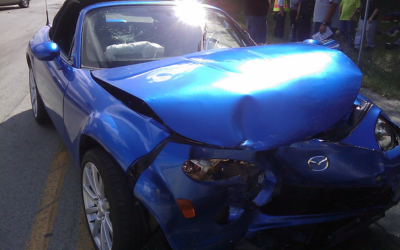Average Car Accident Settlement in Wisconsin
If you’ve been injured in a car accident in Wisconsin, one of the first questions you’re probably asking is: “How much is my case worth?” When you’re dealing with a spinal cord injury from a rear-end collision or a traumatic brain injury after a highway accident near Janesville, it’s a fair (and critical) question. Medical bills stack up, paychecks stop, and the insurance company’s first offer usually doesn’t come close to covering what you’ve lost.
While every case is different, Wisconsin car accident settlements tend to follow patterns based on five key factors: the seriousness of your injuries, your medical costs, lost wages, liability clarity, and the policy limits involved. The insurance company already knows how much your case could be worth. The question is whether they’re going to offer you fair compensation or hope you’ll settle for less.
In this guide, we’ll outline what the average car accident settlement in Wisconsin really looks like, why some insurance claims are worth $15,000 while others reach $1 million or more, and how insurance companies calculate their numbers behind the scenes. If you’re waiting on an offer (or wondering whether you should accept the one in front of you), read this first.
What Is the Average Car Accident Settlement in Wisconsin?
For most Wisconsin car accident cases involving physical injury, the average settlement amount falls between $15,000 and $75,000. Individual claims may result in higher or lower settlement amounts.
At Nowlan Personal Injury Law, our experienced lawyers have recovered millions in verdicts and settlements for Wisconsin clients, including:
- A $3 million policy limits settlement for catastrophic injuries from a trip and fall
- $1.7 million recovered for a client catastrophically injured in a boating accident
- $1.6 million verdict after a semi-truck accident
- $1.5 million settlement for a Milwaukee student injured in a balcony collapse
- $850,000 for a wrist injury that impaired a healthcare worker’s career
- $766,000 verdict for a torn rotator cuff injury
- $650,000 for hip injuries in a car crash
These cases show how widely personal injury settlement values can range, and how aggressively, local representation can make a substantial difference in the final number.
There Is No “Set” Settlement Value, But There Is a Pattern
Insurance companies use formulas. They evaluate your claim based on medical treatment records, liability, lost income, and how persuasive your personal injury attorney is. Rather than relying on formulas and getting fixated on the amount of your medical expenses, our approach is to get to know you personally and to fully understand all of the ways your life has been impacted by the injury.
Medical Expenses: The Foundation of Your Claim
To the insurance company, Medical costs are the starting point of nearly every car accident claim in Wisconsin. They give insurers a baseline to work from as well as a number they can build (or reduce) your payout around. Common expenses include emergency care, surgical procedures, ongoing treatment, prescription medications, chiropractic therapy, and assistive device usage.
If your injuries required significant treatment (or will require future care), your claim’s value increases. However, undocumented treatment or gaps in care are red flags for adjusters. Even legitimate injuries can lose value if they aren’t supported by consistent medical records. This means every diagnosis, doctor’s visit, and procedure needs to be documented in your file. If it’s not in writing, it doesn’t count.
Loss of Wages: Real Dollars Lost from Missed Work
When severe injuries keep you from earning a paycheck, that’s part of your personal injury claim. Lost income is usually straightforward, but often undervalued unless properly documented. We calculate your financial loss using:
- Time missed from work, as verified by employer documentation or pay stubs
- Daily wage or salary breakdown
- Missed bonuses, commissions, or performance pay
- Loss of future earning capacity
In serious cases, we consult with vocational experts to quantify your lost future earnings based on your age, career path, and physical limitations.
Pain and Suffering: Human Impact, Financial Value
Pain and suffering is where cases can increase dramatically in value. In Wisconsin, there’s no cap on pain and suffering damages in most motor vehicle accident claims, but that doesn’t mean the insurer will offer a fair number without pressure. Insurance adjusters typically use the multiplier method:
- Multiply your total medical bills by a number (usually between 1.5 and 5)
- The multiplier depends on injury severity, recovery time, and impact on daily life
Fair compensation for pain and suffering addresses:
- Physical pain and discomfort
- Loss of mobility or function
- Emotional distress (anxiety, depression, PTSD)
- Relationship strain and social withdrawal
- Loss of enjoyment of life
- Reduced quality of life
We often use medical reports, medical professional evaluations, chronic pain journals, and witness statements to document and defend this portion of your claim. If you can show how your life changed, you can get paid for more than just the medical bills and loss of wages.
Liability: Who Caused the Crash, and Can You Prove It?
Wisconsin follows a modified comparative negligence rule. That means fault matters in your case. If you’re 50% or less at fault, your compensatory damages are reduced by that percentage, but if you’re 51% or more at fault, you recover nothing.
Insurance adjusters will look for any reason to shift blame, even if only partially. They’ll analyze evidence such as:
- Police reports and citations
- Eyewitness statements
- Dash cam or surveillance footage
- Road conditions and weather
- Cell phone records
Sometimes, even your own recorded statement is used against you. That’s why we advise clients never to speak with the insurance company directly after an auto accident. Our car accident attorneys aim to build a clear liability picture and aggressively dispute any claims that you’re partially at fault unless the facts justify it.
Insurance Policy Limits: The Cap That May Define Your Ceiling
Even if your injuries are serious and your case is strong, you typically can’t collect more than the available insurance coverage, unless other parties, claims, or policies come into play. Wisconsin’s minimum auto insurance coverage is as follows:
- $25,000 per person for bodily injury
- $50,000 per accident total
If you’re hit by a driver with minimum coverage, your payout may be limited unless:
- The at-fault driver has an umbrella or commercial policy
- You carry UIM (Underinsured Motorist) coverage
- The at-fault party was working at the time (e.g. delivery driver, rideshare driver)
- A third party contributed to the crash (e.g. road hazard, defective vehicle part)
We dig into every insurance policy involved and look for additional sources of coverage, especially in cases involving:
- Commercial vehicles (e.g., trucking companies, fleet operators)
- Rideshare drivers (Uber, Lyft)
- Employers (if the driver was “on the clock”)
- Government entities (if poor road maintenance played a role)
Your attorney’s ability to uncover hidden policy coverage can increase your settlement by tens or hundreds of thousands of dollars.
The Car Accident Lawyer You Hire
Insurance companies track law firms. They know which ones settle early and which ones push cases to trial. If your personal injury lawyer has a reputation for accepting the first decent offer, you’ll see that reflected in your settlement. At Nowlan Personal Injury Law, we prepare every case like it’s going to court. That doesn’t mean every case ends up there, but it does mean the insurance company knows we’re not bluffing. The stronger your legal team, the higher your leverage and the better your result.
When to Settle and When to Go to Trial
Insurance companies are happy to settle on their terms. They’ll test your patience, downplay your injuries, and delay until you’re worn down. The decision to accept a settlement or move toward trial should be based on facts, evidence, and the long-term impact of your injuries, not pressure tactics. Here’s how to tell when it makes sense to settle and when to push forward.
When It Makes Sense to Settle
There’s nothing wrong with an accident victim settling if the offer is right. A well-negotiated settlement puts money in your hands faster, without the time, risk, or stress of trial. We recommend accepting a reasonable settlement only when all of the following are true:
- The offer covers all of your current and future losses as well as property damage
- You’ve reached maximum medical improvement (MMI) (according to your medical providers)
- Your personal injury attorney has reviewed and endorsed the offer
Even if the number sounds “good,” it’s essential to have a lawyer review how it was calculated. Some offers look generous on paper but fall apart under scrutiny. We compare the offer to jury award trends in your region, liability strength, and lifetime impact.
When You Should Consider Litigation
Not all cases are built for trial, but many require the pressure of litigation to get the insurance company to pay attention. You should seriously consider filing a car accident lawsuit if:
- The offer is far below the value of your case
- The insurance company disputes fault
- You have permanent injuries that affect your daily activities
- You’re being delayed, ignored, or lowballed
At Nowlan Personal Injury Law, we don’t bluff. We build every case as if it’s headed to a courtroom. This approach changes how adjusters value your claim from day one.
Should You Accept the First Offer?
Almost never.
The first settlement offer from an insurance company is intended to test you. Are you overwhelmed? Do you know your rights? Are you desperate enough to take the money and walk away?
In most Wisconsin car accident claims, the initial offer doesn’t even come close to covering the full cost of your recovery. Insurance companies are running a cost-control playbook that usually leaves out future medical care or procedures, ongoing physical therapy or rehab, lost future earnings, pain and suffering, and more. If you accept that offer, you waive your right to claim anything else, even if your condition worsens or you later discover new injuries.
A higher settlement offer doesn’t happen because the adjuster changes their mind. It happens because they see risk. That risk comes from:
- Detailed documentation of injuries, treatment, and long-term prognosis
- Expert reports from physicians, economists, or vocational experts
- A clear liability file with no room to shift the blame
- A trial-ready legal team with a proven track record of verdicts and courtroom wins
When an insurer sees that we’re not just looking for a quick check, they shift their tone. They know a lowball offer won’t fly and that ignoring the real value of the case could cost them a lot more at trial.
Why Unrepresented Accident Victims Get Shortchanged
Insurance companies are assessing who you are and whether you have legal representation. If you’re handling your car accident claim on your own, they see that immediately, and it changes how they approach your case. Here’s what they assume (often correctly) if you’re unrepresented:
- You Likely Don’t Know the Full Value of Your Claim: Most people assume a fair settlement covers their ER bills and car repairs. But a full-value claim also includes future medical attention, chronic pain management, and more. Without a legal background or medical experts, you may never know what you’re entitled to. Insurance companies rely on that gap, and it saves them money every single day.
- You May Not Have Access to Expert Witnesses: In larger or more complex claims, success often hinges on what your experts say. That might include medical specialists, vocational experts, economists, and accident reconstructionists. If you’re representing yourself, you’re unlikely to bring in experts, and the insurance company knows it. That weakens your leverage and can seriously limit your settlement.
- You’re Less Likely to File a Lawsuit: Filing a personal injury lawsuit is one of the strongest tools a lawyer has. It signals you’re willing to take the fight further. When you’re on your own, the insurance company assumes you don’t know how to file a complaint in court and you won’t be prepared to go to trial if they call your bluff. As a result, they have no real incentive to offer fair value. They’re betting you’ll settle, no matter how weak the number is.
- You Might Accept the First or Second Offer Out of Pressure: Insurance adjusters are trained to control the process. They’ll sound sympathetic while steering you toward a quick resolution. For someone unfamiliar with the process, these tactics work. People accept lowball offers because they’re stressed, injured, and just want it to be over. The insurer’s job is to capitalize on that moment.
Get a Real Settlement Estimate, Not a Guess
Online calculators and insurance adjusters aren’t going to give you the full picture. If you want to know what your car accident case is really worth in Wisconsin, you need an experienced attorney who understands injury law, state limits, and local courtrooms. We’ll review your case for free and if you hire us, you only pay attorney fees if we win a settlement or jury award for you.
Injured in Wisconsin? Call Nowlan Personal Injury Law Today.
Don’t let the insurance company decide what your case is worth. You deserve more than a quick offer and vague promises. You deserve answers, leverage, and a legal team that knows how to make them pay attention.
At Nowlan Personal Injury Law, we offer focused, aggressive representation built to get results, so call (608) 478-5655 to schedule your free consultation. Let’s build your case the right way, starting today.
Related:
Contact me today for a free consultation.


















